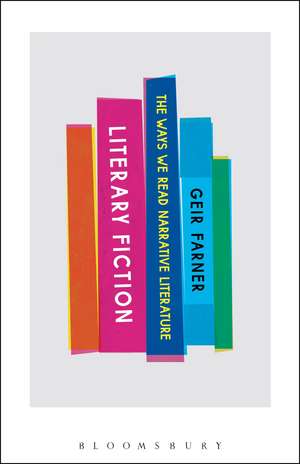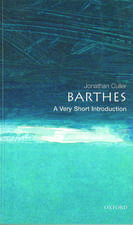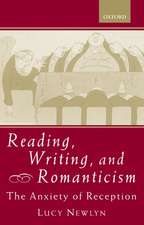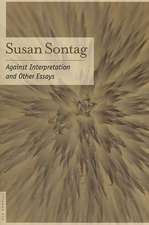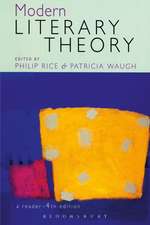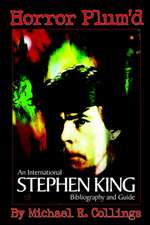Literary Fiction: The Ways We Read Narrative Literature
Autor Professor Geir Farneren Limba Engleză Paperback – 26 mar 2014
| Toate formatele și edițiile | Preț | Express |
|---|---|---|
| Paperback (1) | 239.59 lei 6-8 săpt. | |
| Bloomsbury Publishing – 26 mar 2014 | 239.59 lei 6-8 săpt. | |
| Hardback (1) | 833.06 lei 6-8 săpt. | |
| Bloomsbury Publishing – 26 mar 2014 | 833.06 lei 6-8 săpt. |
Preț: 239.59 lei
Nou
Puncte Express: 359
Preț estimativ în valută:
45.85€ • 47.37$ • 38.16£
45.85€ • 47.37$ • 38.16£
Carte tipărită la comandă
Livrare economică 26 martie-09 aprilie
Preluare comenzi: 021 569.72.76
Specificații
ISBN-13: 9781623560249
ISBN-10: 1623560241
Pagini: 336
Dimensiuni: 140 x 216 x 25 mm
Greutate: 0.45 kg
Editura: Bloomsbury Publishing
Colecția Bloomsbury Academic
Locul publicării:New York, United States
ISBN-10: 1623560241
Pagini: 336
Dimensiuni: 140 x 216 x 25 mm
Greutate: 0.45 kg
Editura: Bloomsbury Publishing
Colecția Bloomsbury Academic
Locul publicării:New York, United States
Caracteristici
Accessible guide to theories on reading and interpretation, especially of narrative fiction.
Notă biografică
Geir Farner is Professor of Dutch Language and Literature in the Department of Literature, Area Studies and European Languages (ILOS) at the University of Oslo, Norway.
Cuprins
1. Introduction2. What is literary fiction?Attempts to define literary fictionIntratextual criteriaExtratextual criteriaThe embedding of real elements in fictionA reader-oriented definition of literary fictionFiction with reservationsHow to distinguish between fact and fiction?Should the author of documentary fiction cite his sources?The embedding of extratextual facts: conclusionThe embedding of fictitious elements in non-fictionNarrative and fiction3. The fictional communication processThe question of genreThe levels of the communication processEarly theories of levelsNarratological theories of levelsThe material textThe mental model of the actionThe relationship between the mental model and the actionThe cognitive contentIdentificationPopular literatureThe cognitive content: terminological alternativesThe truth of the message The incompleteness of the mental modelThe transparency of the mental modelThe two aspects of the mental modelWhy the term mental model?One drawback of the terms signifier, signified and referentDramaLiterary fiction as a speech mode Possible worldsWhat comes first, text or action?4. The cognitive and the aesthetic dimension Definition of the aestheticThe aesthetic dimension in artDoes fiction have an aesthetic dimension?Does the text have an aesthetic function?Does the action have an aesthetic function?Does the mental model have an aesthetic function? Does the cognitive content have an aesthetic function?Does the interplay between the levels have an aesthetic function?Must fiction have an aesthetic dimension in order to be art?The cognitive function and consciousnessEvidence of the cognitive function5. The delimitation of the literary work The text and the mental model of the actionThe messageDrama and lyric poetryAmbiguous textsReading in another order and repeated readingsThe simultaneity of the levelsOther theories6. Intention and messageThe message as perceived by the receiverDifferent forms of communicationThe many faces of the authorThe message as perceived by the sender Does the work always reflect the author's own views?The relationship between the latent and the received messageTo what extent is information about the author's intention available?The expectations of the readerThe author's responsibility for the received messageConclusionInterpretive strategies 7. Problems related to the sender The narrator and the narrative actKäte Hamburger's theoryThe nature of the narratorThe role of the receiverAttachment8. The structure of the action The mental model and the actionWhat is the action?The action as part of a larger fictional worldProblems with the definition of story The author's influence on the actionThe complexity of the actionThe relationship between events and charactersAction-orientation and character-orientation as forms of selectionAttempts at simplificationThe smallest meaningful elements of the actionHow are these basic elements related to Propp's and Greimas's models? The characters' mode of existence Flat and round charactersThe action as vehicle for the messageSetting9 SelectionTheories about durationSelectionTime and its contentQuantitative selectionScene, summary, ellipsis, pause and stretchThe problem pause 10. VoiceTemporal relations Identity and levelTerminological problemsThe significance of the author's choice of grammatical personThe report of speech and thoughtsInterference of the narratorComments of the narratorHumour as a manifestation of voiceIronyOther kinds of indirect communication11 Viewpoint, focalizationViewpoint or focalization?Viewpoint in non-fiction, film and dramaViewpoint in the novel and the short storyOmniscience and perceptionPosition: internal and external viewpointDepthBreadthStabilityRewriting in the first person The point of view in the first-person novelThe narrator's viewpoint: double focalization?Is there always a viewpoint (or focalization)?Ambiguous viewpoint Viewpoint and voiceZero focalization?Internal viewpoint and subjectivityViewpoint and identificationConclusion12 Frequency13 Order14. SuspenseWhat is suspense?Various forms of suspenseSuspense in Effi BriestArtificial suspense15. The functions of literary fictionDidactic literature and simplificationResult- and process-orientationNon-cognitive functions16. EvaluationTo what extent is evaluation inevitable?How subjective is evaluation?Which aspects of the work are subject to evaluation?Evaluation criteria for the cognitive contentTruthImportanceRelevanceNovelty and differenceEntertainmentEvaluation criteria for form alone and form and content as a wholeWholenessComplexity and simplicityOpennessCriteria related to phatic functionProfessional competenceCriteria linked to timeCriteria linked to languageExtratextual factorsWho is entitled to evaluate?Conclusion17. ConclusionBibliographyIndex
Recenzii
With examples taken from a variety of national literatures, Literary Fiction patiently revisits all the basic notions in narrative theory. Farner's observations are astute, and his solutions provocative. Chapters on suspense and the evaluative component in interpretation provide the icing on the cake.
An engaging read, Farner's Literary Fiction is an exhaustive retelling of the development of the various schools of literary criticism, from post-WW II domination of New Criticism through the wave of semioticians, political ideologues, and then finally the post-postmodernists, who see literary criticism as a rainbow palette from which one may blend critical approaches. The volume presents a rewarding continental perspective of modern "lit crit." The book will prove useful as a backgrounder or as a brief refresher. Summing Up: Recommended. Upper-division undergraduates through faculty.
What can a linguist do for Americanist literary critics? Plenty. As a rhetorician and cognitivist, Geir Farner brings more sources to bear on literary study than does the usual linguist. He offers not only revisions of old theories, but also shows how literary fiction communicates and what it communicates. As such, these new arguments bridge gaps between narratology in general, and cognitive theory in particular. . Clear and original, Farner's study comprises an important argument in narratology and cognitive theory. . [T]his study will be helpful for a wide range of readers-from advanced students through senior scholars. In particular, Americanist literary critics and rhetoricians who are interested in narratology's application to historicist and feminist matters will benefit from this study. And so will cultural and intellectual historians studying historiography, for this work is probably the most relevant exploration of literary form's influence on narrative since Hayden White's Metahistory (1973), The Content of the Form (1987), and Figural Realism (1999). As such, this work deserves a high place on the Parnassus of American Studies.
An engaging read, Farner's Literary Fiction is an exhaustive retelling of the development of the various schools of literary criticism, from post-WW II domination of New Criticism through the wave of semioticians, political ideologues, and then finally the post-postmodernists, who see literary criticism as a rainbow palette from which one may blend critical approaches. The volume presents a rewarding continental perspective of modern "lit crit." The book will prove useful as a backgrounder or as a brief refresher. Summing Up: Recommended. Upper-division undergraduates through faculty.
What can a linguist do for Americanist literary critics? Plenty. As a rhetorician and cognitivist, Geir Farner brings more sources to bear on literary study than does the usual linguist. He offers not only revisions of old theories, but also shows how literary fiction communicates and what it communicates. As such, these new arguments bridge gaps between narratology in general, and cognitive theory in particular. . Clear and original, Farner's study comprises an important argument in narratology and cognitive theory. . [T]his study will be helpful for a wide range of readers-from advanced students through senior scholars. In particular, Americanist literary critics and rhetoricians who are interested in narratology's application to historicist and feminist matters will benefit from this study. And so will cultural and intellectual historians studying historiography, for this work is probably the most relevant exploration of literary form's influence on narrative since Hayden White's Metahistory (1973), The Content of the Form (1987), and Figural Realism (1999). As such, this work deserves a high place on the Parnassus of American Studies.
